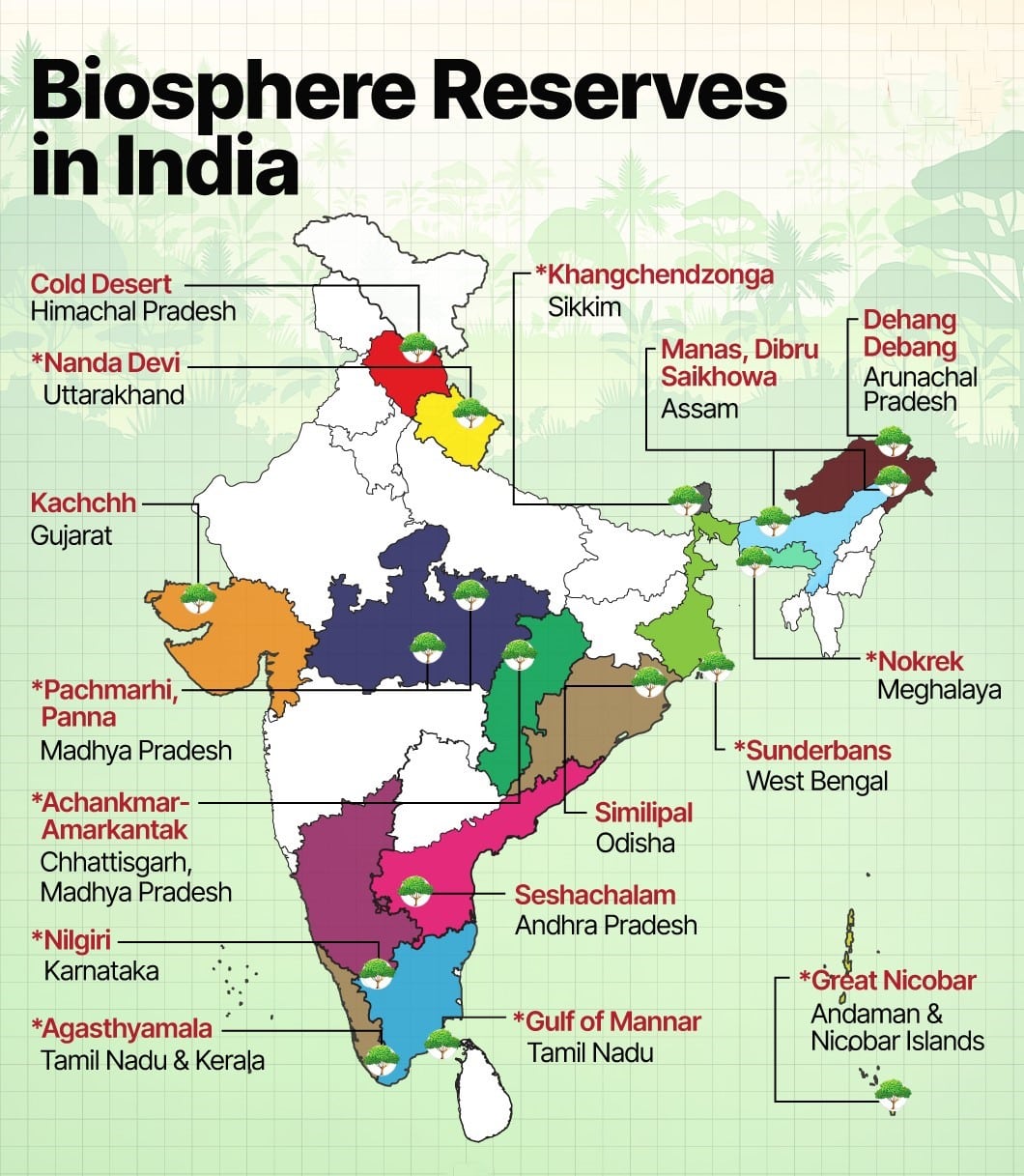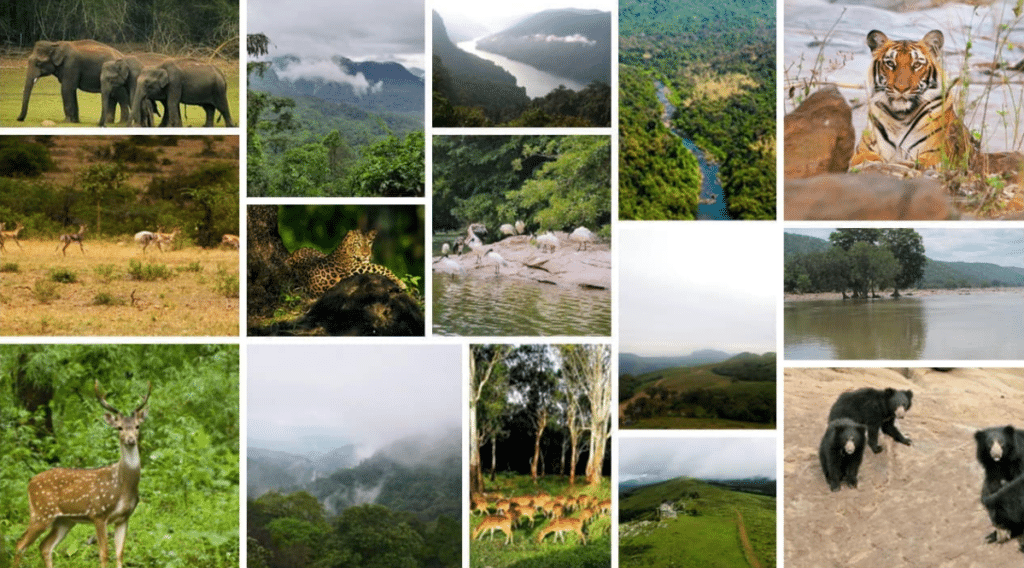
Quick Summary
Table of Contents
A UNESCO Biosphere Reserve in India is a unique area recognized by UNESCO (the United Nations Educational, Scientific and Cultural Organization) for its natural beauty and unique ecosystem. These areas are protected to conserve biodiversity (the variety of life) and promote sustainable development.
Biosphere Reserves in India are places where humans and nature can live together without harming the environment. They are home to many rare and endangered plants, animals, and bird species.
India has several UNESCO Biosphere Reserves, like the Sundarbans in West Bengal and Nilgiri in Tamil Nadu, which protect wildlife, forests, and water resources while supporting local communities.
A Biosphere Reserve is a protected area designated by UNESCO to conserve biodiversity, ecosystems, and genetic diversity. These reserves promote sustainable development while balancing people’s and nature’s needs. They protect natural habitats, wildlife, and plant species while supporting scientific research and education.
| Details | Information |
| Total Biosphere Reserves in India | 18 |
| UNESCO Recognized Biosphere Reserves | 12 |
| Largest Biosphere Reserve (Area) | Gulf of Kachchh (12,454 km²) |
| First Established Biosphere Reserve | Nilgiri (1986) |
| Smallest Biosphere Reserve (Area) | Dibru-Saikhowa (765 km²) |
Biosphere reserves are divided into three main zones, each serving a specific purpose in fostering the coexistence of nature and human activities. Let’s explore these zones in simple terms.
1. Core Zone
2. Buffer Zone
3. Transition Zone
Biosphere reserves are significant because they help balance caring for nature, allowing development, and ensuring we use resources wisely. This helps both the environment and the people who live there.
The World Network of Biosphere Reserves (WNBR) currently comprises 738 sites in 134 countries, including 22 transboundary sites. The distribution of these reserves across the world is as follows:
National governments nominate these reserves and remain under the sovereign jurisdiction of the states where they are located. They involve local communities and all interested stakeholders in planning and management.
India has 18 Biosphere Reserves, which are designated areas for the conservation of biodiversity. These reserves help protect ecosystems, wildlife, and plant species. They also support sustainable development and research.
There are 18 biosphere reserves in India, each with its unique ecological treasures. Here’s a list of all 18 biosphere reserves of India:
| No. | Name of Biosphere Reserve | Year of Notification | Location (States) |
| 1 | Nilgiri | 1986 | Covers parts of the Anupur and Dindori districts of M.P. and the Bilaspur districts of Chhattisgarh State. |
| 2 | Nanda Devi | 1988 | Part of Chamoli, Pithoragarh, and Bageshwar districts (Uttarakhand). |
| 3 | Nokrek | 1988 | Part of Garo Hills (Meghalaya). |
| 4 | Great Nicobar | 1989 | Southernmost islands of Andaman And Nicobar (A&N Islands). |
| 5 | Gulf of Mannar | 1989 | The Indian part of the Gulf of Mannar is between India and Sri Lanka (Tamil Nadu). |
| 6 | Manas | 1989 | Part of Kokrajhar, Bongaigaon, Barpeta, Nalbari, Kamprup, and Darang districts (Assam). |
| 7 | Sunderbans | 1989 | Part of the delta of the Ganges and Brahmaputra river system (West Bengal). |
| 8 | Simlipal | 1994 | Part of the Mayurbhanj district (Orissa). |
| 9 | Dibru-Saikhowa | 1997 | Part of Dibrugarh and Tinsukia Districts (Assam). |
| 10 | Dehang-Dibang | 1998 | Part of Siang and Dibang Valley in Arunachal Pradesh. |
| 11 | Pachmarhi | 1999 | Parts of Betul, Hoshangabad, and Chindwara districts of Madhya Pradesh. |
| 12 | Khangchendzonga | 2000 | Parts of Khangchendzonga hills and Sikkim. |
| 13 | Agasthyamalai | 2001 | Neyyar, Peppara, and Shendurney Wildlife Sanctuaries and their adjoining areas in Kerala. |
| 14 | Achanakamar – Amarkantak | 2005 | Covers parts of the Anupur and Dindori districts of M.P. and parts of Bilaspur districts of Chhattisgarh State. |
| 15 | Kachchh | 2008 | Part of Kachchh, Rajkot, Surendra Nagar, and Patan Civil Districts of Gujarat State. |
| 16 | Cold Desert | 2009 | Pin Valley National Park and surroundings; Chandratal and Sarchu & Kibber Wildlife Sanctuary in Himachal Pradesh. |
| 17 | Seshachalam Hills | 2010 | Seshachalam Hill Ranges covers parts of the Chittoor and Kadapa districts of Andhra Pradesh. |
| 18 | Panna | 2011 | Part of Panna and Chhattarpur districts in Madhya Pradesh. |
There are 18 UNESCO biosphere reserves in India, 12 of which are protected. Here’s a list of all 12 Protected UNESCO Biosphere Reserves of India:
| YEAR | NAME | STATES |
| 2000 | Nilgiri Biosphere Reserve | Tamil Nadu |
| 2001 | Gulf of Mannar Biosphere Reserve | Tamil Nadu |
| 2001 | Sundarbans Biosphere Reserve | West Bengal |
| 2004 | Nanda Devi Biosphere Reserve | Uttarakhand |
| 2009 | Pachmarhi Biosphere Reserve | Madhya Pradesh |
| 2009 | Nokrek Biosphere Reserve | Meghalaya |
| 2009 | Simlipal Biosphere Reserve | Odisha |
| 2012 | Achanakmar-Amarkantak Biosphere Reserve | Chhattisgarh |
| 2013 | Great Nicobar Biosphere Reserve | Great Nicobar |
| 2016 | Agasthyamala Biosphere Reserve | Kerala and Tamil Nadu |
| 2018 | Kanchenjunga Biosphere Reserve | Part of North and West Sikkim districts |
| 2020 | Panna Biosphere Reserve | Madhya Pradesh |

Map of UNESCO Biosphere Reserve in India
Ever wondered where to find the perfect blend of conservation, cultural heritage, and breathtaking landscapes in India? Look no further than the UNESCO Biosphere Reserve of India! These designated areas offer a unique opportunity to explore diverse ecosystems while supporting sustainable practices.
Using a map, you can embark on a journey to explore the UNESCO Biosphere Reserve in India, a treasure trove of nature, culture, and sustainable practices!
UNESCO’s Man and the Biosphere Programme (MAB) launched an intergovernmental scientific initiative in 1971. The Man and Biosphere (MAB) Programme is like a big plan by UNESCO to ensure we care for our planet. It’s all about finding innovative ways for people and nature to live together peacefully. This program is like a bridge, connecting three essential things:
So, MAB is a team effort to ensure we have a happy, thriving planet for a long time.

India boasts a rich tapestry of ecosystems, protected through a multi-tiered system: National Parks, Wildlife Sanctuaries, and Biosphere Reserves. Each designation offers a unique approach to conservation:
The Ministry of Forests and Environment in India has identified several potential sites for designation as Biosphere Reserves, aiming to enhance conservation and sustainable development. Below is the list of these potential sites:
Biosphere conservation is like teamwork among unique places on Earth called biosphere reserves. It involves everyone working together to protect our environment, from scientists to regular people.
Integrating biosphere reserves with other protected areas, such as national parks, signifies a strategic alliance. This collaboration, rooted in a comprehensive plan, unites diverse stakeholders in a shared mission to ensure the enduring well-being of our planet’s ecosystems for the benefit of present and future generations.
UNESCO Biosphere Reserve in India is a crucial topic for the UPSC exam, particularly in the Environment and Ecology section of the General Studies paper. Here’s a breakdown of key points to understand:
By understanding the significance and functionalities of the UNESCO Biosphere Reserve of India, you can effectively address this topic in the UPSC exam.
In recognizing the critical role of the UNESCO Biosphere Reserve in India, we celebrate not just protected areas but also the guardians of our planet’s natural harmony. Like stewards of an ecological legacy, these reserves shape a sustainable and biodiverse future. Biosphere reserves exemplify the path toward coexistence by fostering a delicate balance between human activities and environmental preservation.
Also Read:-
Read the related articles and the “UNESCO Biosphere Reserve of India” by visiting the links above.

Ans. India has 18 Biosphere Reserves that protect biodiversity and ecosystems.
Ans. The UNESCO-designated World Network of Biosphere Reserves (WNBR) included the Khangchendzonga Biosphere Reserve as the 11th biosphere reserve from India.
Ans. UNESCO designated the Nilgiri Biosphere Reserve as India’s first biosphere reserve.
Ans. UNESCO’s Man and the Biosphere (MAB) program recently added 11 new biosphere reserves in 2023, including the Sunshine Coast Biosphere Reserve in Australia and the Doumba-Rey Biosphere Reserve in Cameroon.
Ans. The largest Biosphere reserve in India is the Gulf of Kachchh, Gujarat, and the smallest Biosphere Reserve in India is Dibru-Saikhowa in Assam.
Ans. Launched in 1971, UNESCO’s Man and the Biosphere Program (MAB) is an Intergovernmental Scientific Program that aims to establish a scientific basis for improving relationships between people and their environments.
Ans. In India, the Biosphere Reserve is declared by the Union Ministry of Environment, Forest and Climate Change (MoEFCC), based on recommendations from the State Government and the Indian National Man and Biosphere (MAB) Committee.
Ans. The World Network of Biosphere Reserves is a global network of protected areas that promote biodiversity conservation, sustainable development, and research, coordinated by UNESCO
Ans. The Man and the Biosphere (MAB) Programme is a UNESCO (1971) initiative that promotes sustainable development by balancing biodiversity conservation and human development through Biosphere Reserves.
Ans. The smallest Biosphere Reserve in India is the Sundarbans Biosphere Reserve in West Bengal.

Authored by, Amay Mathur | Senior Editor




Amay Mathur is a business news reporter at Chegg.com. He previously worked for PCMag, Business Insider, The Messenger, and ZDNET as a reporter and copyeditor. His areas of coverage encompass tech, business, strategy, finance, and even space. He is a Columbia University graduate.
Editor's Recommendations
Chegg India does not ask for money to offer any opportunity with the company. We request you to be vigilant before sharing your personal and financial information with any third party. Beware of fraudulent activities claiming affiliation with our company and promising monetary rewards or benefits. Chegg India shall not be responsible for any losses resulting from such activities.
Chegg India does not ask for money to offer any opportunity with the company. We request you to be vigilant before sharing your personal and financial information with any third party. Beware of fraudulent activities claiming affiliation with our company and promising monetary rewards or benefits. Chegg India shall not be responsible for any losses resulting from such activities.